HONDA S2000 2002 1.G Owners Manual
Manufacturer: HONDA, Model Year: 2002, Model line: S2000, Model: HONDA S2000 2002 1.GPages: 277, PDF Size: 4.81 MB
Page 231 of 277

Look f or any obvious coolant leaks,
such as a split radiator hose.
Everything is still extremely hot,
so use caution. If you f ind a leak, it
must be repaired bef ore you
continue driving (seeon page ). If you don’t f ind an obvious leak,
check the coolant level in the
radiator reserve tank (see page
). If the level is below the
MIN mark, add coolant to halfway
between the MIN and MAX marks. Using gloves or a large heavy
cloth, turn the radiator cap
counterclockwise, without pushing
down, to the f irst stop. This
releases any remaining pressure in
the cooling system. After the
pressure releases, push down on
the cap and turn it until it comes
off.
If there was no coolant in the
reserve tank, you may also have to
add coolant to the radiator. Let the
engine cool down until the reading
reaches the middle of the
temperature gauge, or lower,
bef ore checking the radiator.
6.
7.9.
8.
247 126
Emergency
Towing
If Your Engine Overheats
T aking Care of t he Unexpect ed
232 Removing the radiator cap
while the engine is hot can
cause the coolant to spray out,
seriously scalding you.
Always let the engine and
radiator cool down before
removing the radiator cap.
Page 232 of 277

Start the engine and set the
temperature control dial to
maximum. Add coolant to the
radiator up to the base of the f iller
neck. If you do not have the
proper coolant mixture available,
you can add plain water.
Remember to have the cooling
system drained and ref illed with
the proper mixture as soon as you
can.Put the radiator cap back on
tightly. Run the engine and watch
the temperature gauge. If it goes
back to the red mark, the engine
needs repair. (See
on page .) If the temperature stays normal,
check the coolant level in the
radiator reserve tank. If it has
gone down, add coolant to the
MAX mark. Put the cap back on
tightly.
10.
12.
11.
247Emergency
Towing
If Your Engine Overheats
T aking Care of t he Unexpect ed 233
Page 233 of 277
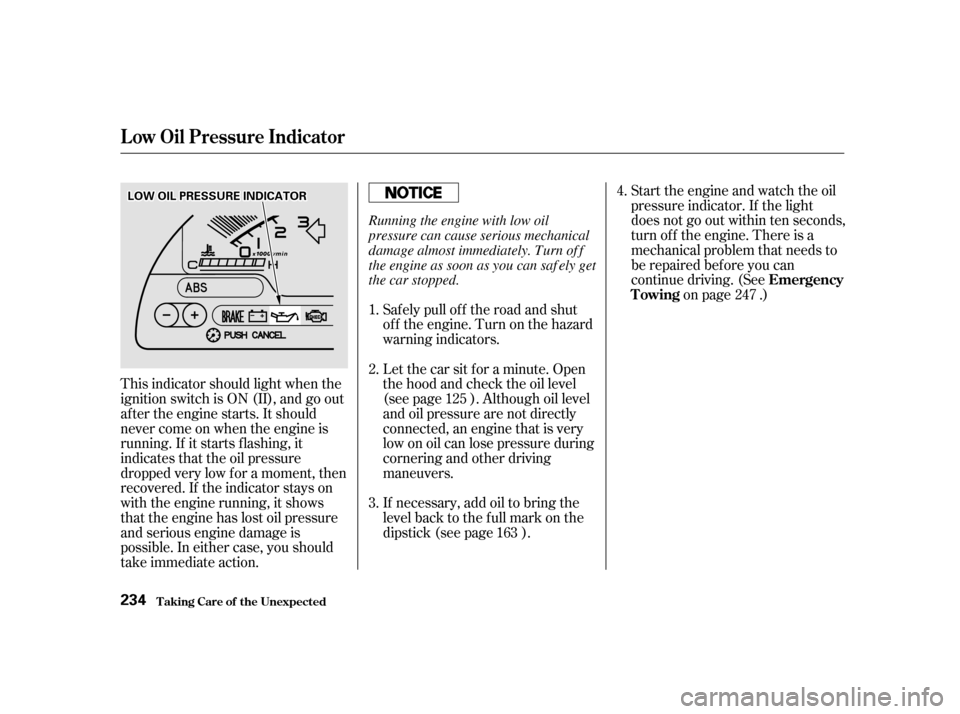
This indicator should light when the
ignition switch is ON (II), and go out
af ter the engine starts. It should
never come on when the engine is
running. If it starts f lashing, it
indicates that the oil pressure
dropped very low f or a moment, then
recovered. If the indicator stays on
with the engine running, it shows
that the engine has lost oil pressure
and serious engine damage is
possible. In either case, you should
take immediate action.Start the engine and watch the oil
pressure indicator. If the light
does not go out within ten seconds,
turn of f the engine. There is a
mechanical problem that needs to
be repaired bef ore you can
continue driving. (See
on page .)
Saf ely pull of f the road and shut
of f the engine. Turn on the hazard
warning indicators.
If necessary, add oil to bring the
level back to the full mark on the
dipstick (see page ).
Letthecarsitforaminute.Open
the hood and check the oil level
(see page ). Although oil level
and oil pressure are not directly
connected, an engine that is very
low on oil can lose pressure during
cornering and other driving
maneuvers.
1. 2. 3. 4.
125 163 247
Emergency
Towing
L ow Oil Pressure Indicator
T aking Care of t he Unexpect ed
234
LLOOWWOOIILLPPRREESSSSUURREEIINNDDIICCAATTOORR
Running the engine with low oil
pressure can cause serious mechanical
damage almost immediately. Turn of f
the engine as soon as you can saf ely get
the car stopped.
Page 234 of 277
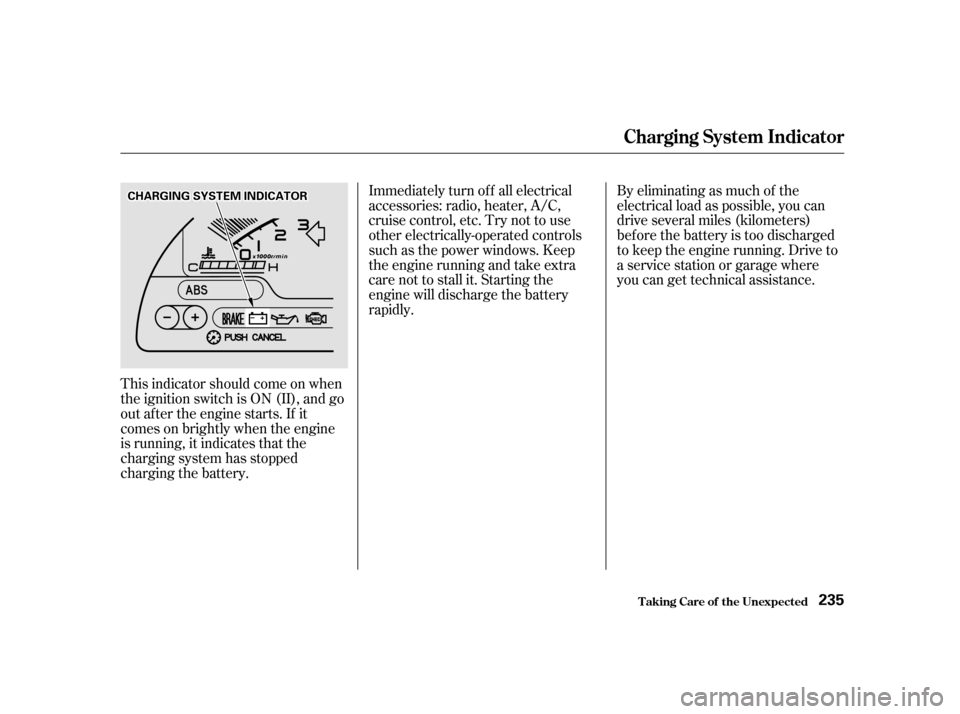
This indicator should come on when
the ignition switch is ON (II), and go
out af ter the engine starts. If it
comes on brightly when the engine
is running, it indicates that the
charging system has stopped
charging the battery.By eliminating as much of the
electrical load as possible, you can
drive several miles (kilometers)
before the battery is too discharged
to keep the engine running. Drive to
a service station or garage where
you can get technical assistance.
Immediately turn of f all electrical
accessories: radio, heater, A/C,
cruise control, etc. Try not to use
other electrically-operated controls
such as the power windows. Keep
the engine running and take extra
care not to stall it. Starting the
engine will discharge the battery
rapidly.
Charging System Indicator
T aking Care of t he Unexpect ed
235
CCHHAARRGGIINNGGSSYYSSTTEEMMIINNDDIICCAATTOORR
Page 235 of 277
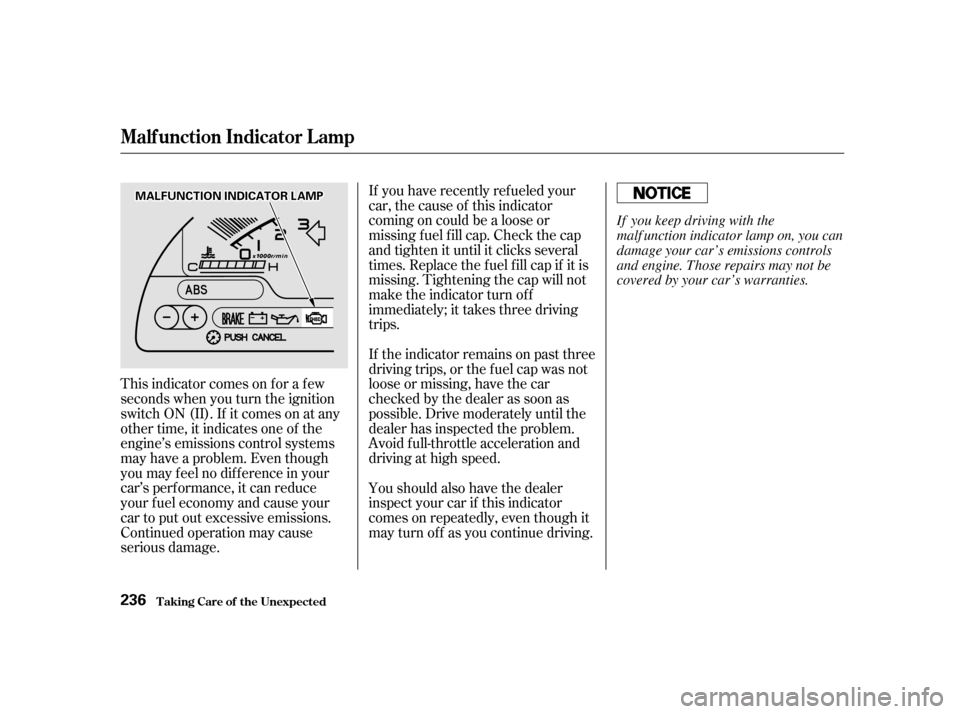
This indicator comes on f or a f ew
seconds when you turn the ignition
switch ON (II). If it comes on at any
other time, it indicates one of the
engine’s emissions control systems
may have a problem. Even though
you may f eel no dif f erence in your
car’s perf ormance, it can reduce
your f uel economy and cause your
car to put out excessive emissions.
Continued operation may cause
serious damage.If you have recently ref ueled your
car, the cause of this indicator
coming on could be a loose or
missing f uel f ill cap. Check the cap
and tighten it until it clicks several
times. Replace the fuel fill cap if it is
missing. Tightening the cap will not
make the indicator turn of f
immediately; it takes three driving
trips.
If the indicator remains on past three
driving trips, or the f uel cap was not
loose or missing, have the car
checked by the dealer as soon as
possible. Drive moderately until the
dealer has inspected the problem.
Avoid full-throttle acceleration and
driving at high speed.
Youshouldalsohavethedealer
inspect your car if this indicator
comes on repeatedly, even though it
may turn of f as you continue driving.
Malf unction Indicator L amp
T aking Care of t he Unexpect ed
236
MMAALLFFUUNNCCTTIIOONNIINNDDIICCAATTOORRLLAAMMPP
If you keep driving with the
malf unction indicator lamp on, you can
damage your car’s emissions controls
and engine. Those repairs may not be
covered by your car’s warranties.
Page 236 of 277

Your car has certain ‘‘readiness
codes’’ that are part of the on-board
diagnostics f or the emissions
systems. In some states, part of the
emissions testing is to make sure
these codes are set. If they are not
set, the test cannot be completed.
If your car’s battery has been
disconnected or gone dead, these
codes are erased. It takes several
days of driving under various
conditions to set the codes again.If possible, do not take your vehicle
f or a state emissions test until the
readiness codes are set. To check if
they are set, turn the ignition ON (II),
but do not start the engine. The
Malf unction Indicator Lamp will
come on f or 20 seconds. If it then
goes of f , the readiness codes are set.
If it blinks 5 times, the readiness
codes are not set. Ref er to State
Emissions Testing f or more
inf ormation.(See page and .)
261 262
T aking Care of t he Unexpect ed
Readiness Codes
Malf unction Indicator L amp
237
Page 237 of 277
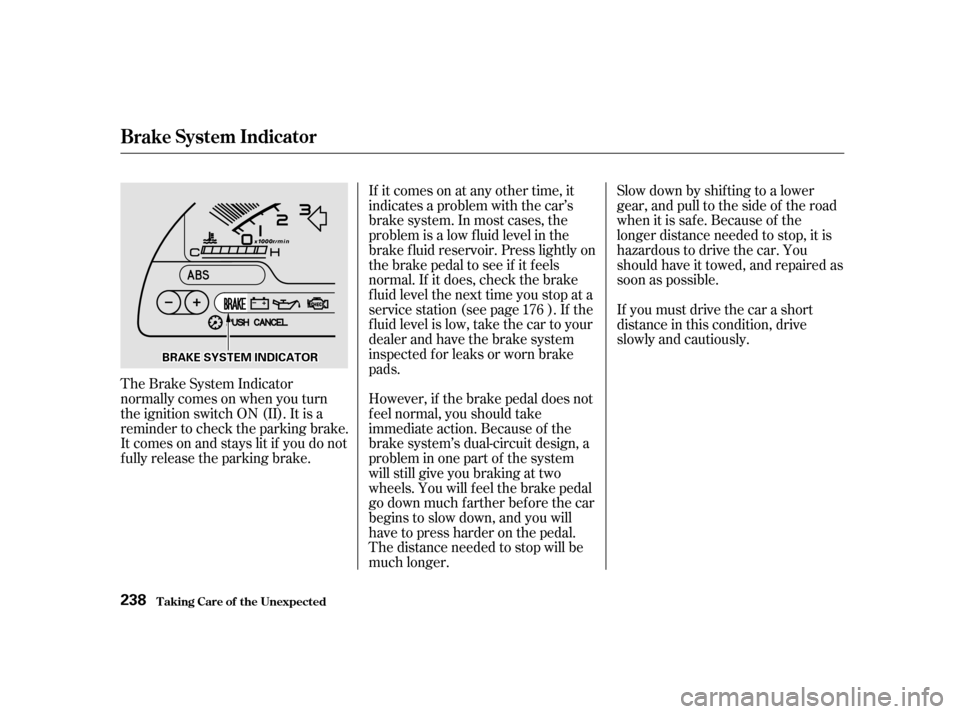
Slow down by shif ting to a lower
gear, and pull to the side of the road
when it is saf e. Because of the
longer distance needed to stop, it is
hazardous to drive the car. You
should have it towed, and repaired as
soon as possible.
If it comes on at any other time, it
indicates a problem with the car’s
brake system. In most cases, the
problem is a low f luid level in the
brake f luid reservoir. Press lightly on
the brake pedal to see if it f eels
normal. If it does, check the brake
f luid level the next time you stop at a
service station (see page ). If the
fluid level is low, take the car to your
dealer and have the brake system
inspected f or leaks or worn brake
pads.
However, if the brake pedal does not
f eel normal, you should take
immediate action. Because of the
brake system’s dual-circuit design, a
problem in one part of the system
will still give you braking at two
wheels. You will f eel the brake pedal
go down much f arther bef ore the car
begins to slow down, and you will
have to press harder on the pedal.
The distance needed to stop will be
much longer. If you must drive the car a short
distance in this condition, drive
slowly and cautiously.
The Brake System Indicator
normallycomesonwhenyouturn
the ignition switch ON (II). It is a
reminder to check the parking brake.
It comes on and stays lit if you do not
f ully release the parking brake. 176
Brake System Indicator
T aking Care of t he Unexpect ed
238
BBRRAAKKEESSYYSSTTEEMMIINNDDIICCAATTOORR
Page 238 of 277
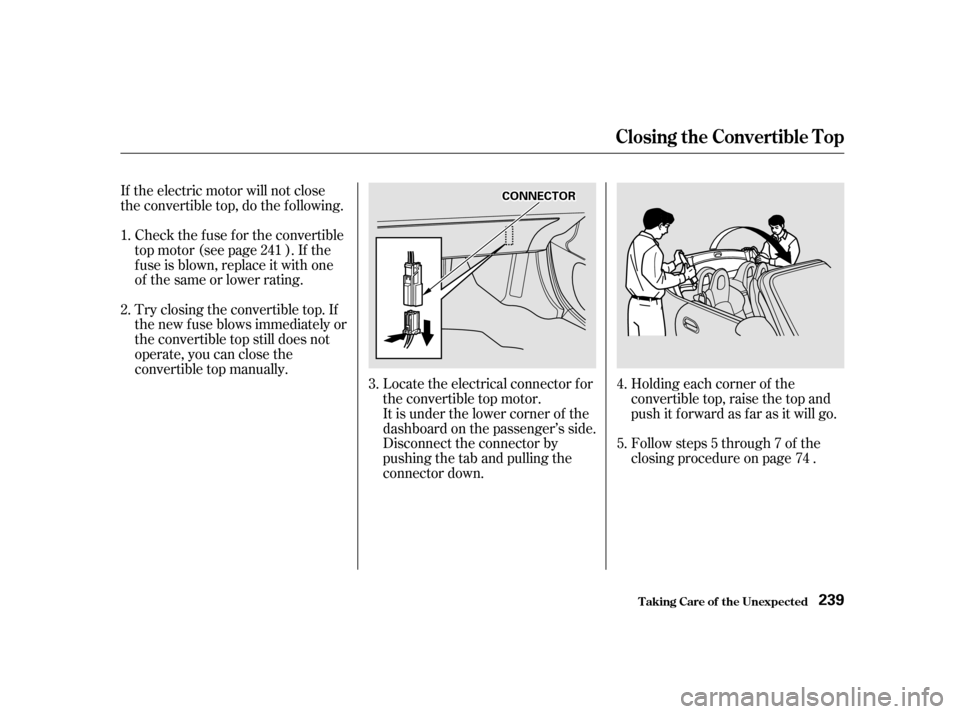
Holding each corner of the
convertible top, raise the top and
push it forward as far as it will go.
Follow steps 5 through 7 of the
closing procedure on page .
If the electric motor will not close
the convertible top, do the f ollowing.
Check the f use f or the convertible
top motor (see page ). If the
f use is blown, replace it with one
of thesameorlowerrating.
Try closing the convertible top. If
the new f use blows immediately or
the convertible top still does not
operate, you can close the
convertible top manually. Locate the electrical connector f or
the convertible top motor.
It is under the lower corner of the
dashboard on the passenger’s side.
Disconnect the connector by
pushing the tab and pulling the
connector down.
3.
1. 2.
4. 5.
241
74
Closing the Convertible Top
T aking Care of t he Unexpect ed239
CCOONNNNEECCTTOORR
Page 239 of 277
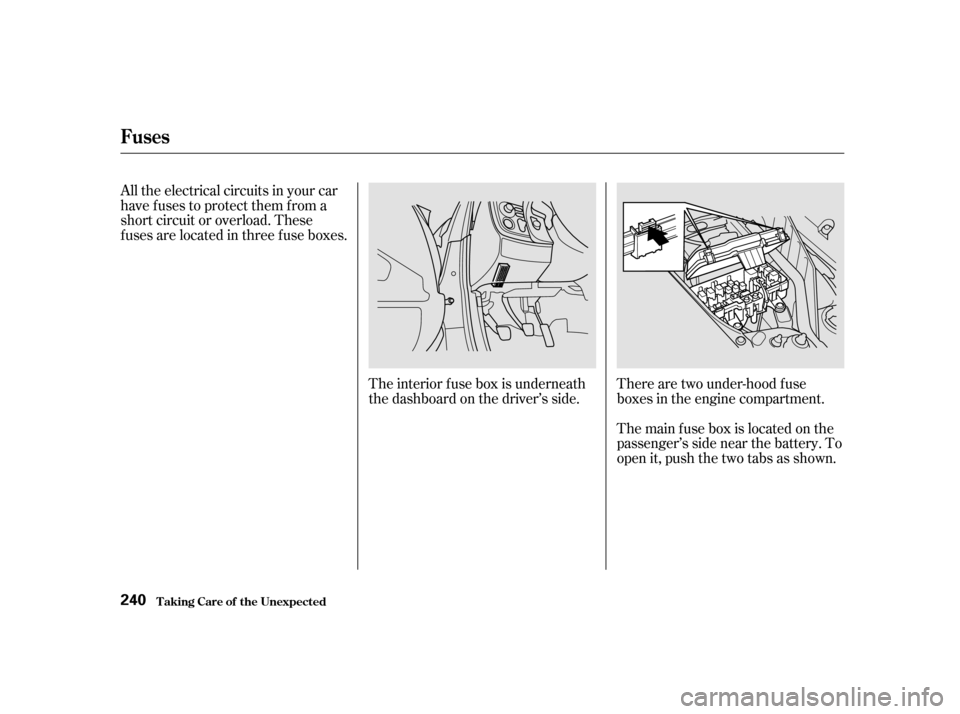
The interior f use box is underneath
the dashboard on the driver’s side.There are two under-hood f use
boxes in the engine compartment.
Themainfuseboxislocatedonthe
passenger’s side near the battery. To
open it, push the two tabs as shown.
All the electrical circuits in your car
have fuses to protect them from a
short circuit or overload. These
f uses are located in three f use boxes.
Fuses
T aking Care of t he Unexpect ed
240
Page 240 of 277
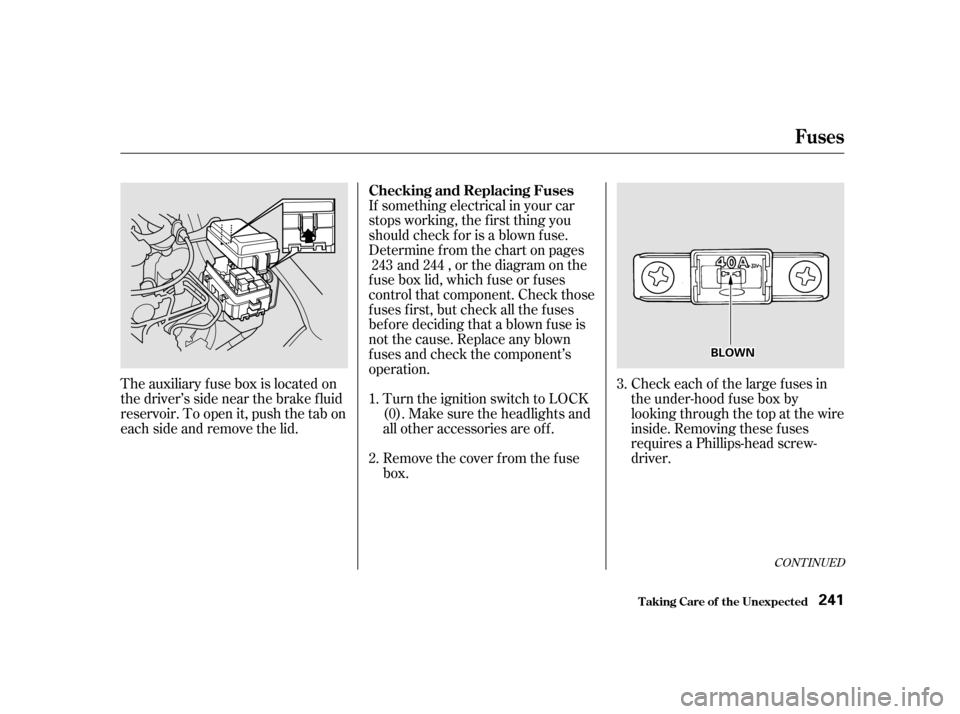
The auxiliary f use box is located on
thedriver’ssidenearthebrakefluid
reservoir. To open it, push the tab on
each side and remove the lid.If something electrical in your car
stops working, the f irst thing you
should check f or is a blown f use.
Determine f rom the chart on pages
and , or the diagram on the
f use box lid, which f use or f uses
control that component. Check those
f uses f irst, but check all the f uses
bef ore deciding that a blown f use is
not the cause. Replace any blown
f uses and check the component’s
operation.
Turn the ignition switch to LOCK
(0). Make sure the headlights and
all other accessories are off.
Remove the cover f rom the f use
box. Check each of the large f uses in
the under-hood f use box by
looking through the top at the wire
inside. Removing these f uses
requires a Phillips-head screw-
driver.
1. 2. 3.
243 244
CONT INUED
Checking and Replacing Fuses
Fuses
T aking Care of t he Unexpect ed
241
BBLLOOWWNN